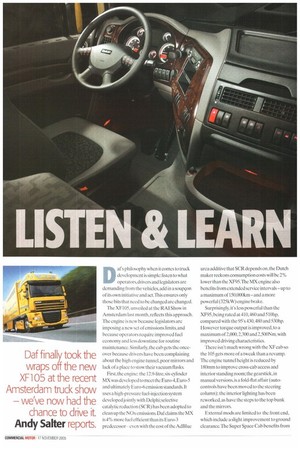LISTEN & LEARN
Page 32

Page 33

If you've noticed an error in this article please click here to report it so we can fix it.
Dar s philosophy when it comes to truck development is simple: listen to what operators,d rivers and legislators are demanding from the vehicles, add in a soupcon of its own initiative and act.This ensures only those bits that need to be changed are changed.
The XE105, unveiled at the RA! Show in Amsterdam last month , reflects this approach. The engine is new because legislators are imposing a new set of emissions limits, and because operators require improved fuel economy and less downtime for routine maintenance. Similarly, the cab gets the onceover because drivers have been complaining about the high engine tunnel, poor mirrors and lack of a place to stow their vacuum flasks.
First, the engine: the 12.9-litre,six-cylinder MX was developed to meet the Euro-4,Euro-5 and ultimately Euro-6 emission standards. It uses a high-pressure fuel-injection system developed jointly with Delphi; selective catalytic reduction (SCR) has been adopted to clean up the NOx emissions. Daf claims the MX is 4% more fuel efficient than its Euro-3 predecessor — even with the cost of theAcIBlue urea additive that SCR depends on,the Dutch maker reckons consumption costs will be 2% lower than the XF95.The MX engine also benefits from extended service intervals—up to a maximum of 150,000km— and a more powerful (325kW) engine brake.
Surprisingly, it's less powerful than the XF95, being rated at 410,460 and 510hp, compared with the 95's 430.480 and 530hp. However torque output is improved, to a maximum of 2,000,2,300 and 2,500Nm, with improved driving characteristics.
There isn't much wrong with the XF cab so the 105 gets more of a tweak than a revamp. The engine tunnel height is reduced by 180mm to improve cross-cab access and interior standing room; the gearstick, in manual versions, is a fold-fiat affair (autocontrols have been moved to the steering column); the interior lighting has been reworked, as have the steps to the top bunk and the mirrors.
External mods are limited to the front end, which include a slight improvement to ground clearance.The Super Space Cab benefits from a stylish new roof line; its overall height has been raised by about an. inch. Chassis changes include mounting the air tanks inside the chassis to make way for the AdBlue tanks.
List price for the XF105 will be about 8% higher than the 95 and the new models 150kg heavier than its predecessor, mostly due to the additional SCR equipment.
On the road
IL sounds good, hut what's it like to drive? In a word: excellent.
We were particularly impressed by the new engine. Power and torque curves are such that the revs rarely have to be taken outside the 1,1 00-1,50Orpm green band to make good progress. Maximum torque is on offer through this range and at 1,500rpm the engine is virtually at maximum available power too. On the road this manifests itself in its willingness to get on with things when accelerating and its exceptional lugging ability on the hills The MX engine doesn't know when to give in — time and again we reached for the gearshift as the revs dropped to 1,3(X)rpm on some of the tougher gradients, only for the engine to dig in and recover without a fuel-sapping gearshift.
The XF1 05 is equally at home on the descents. As well as being more powerful overall, the engine brake is a darned site better at lower revs. One of our biggest criticisms of the XF95 was that its engine brake offered poor retardation at low revs, essential for check braking on UK motorway gradients. Now this has been so effectively addressed that if it's used properly operators can look forward to reduced service brake wear. But it's a pity the engine brake is a £1,400 option.
Irk-cab noise remains low and the improvements to the cab interior combine to ensure the XF retains its position in our top three of longhaul cab favourites. Particularly nifty is the pulley system to lift the top bunk out of the way and the fold-down steps that give easy access to it —Iveco designers take note on both counts.
A consequence of the improvements to the mirrors (and there's no doubting they needed to be made bigger) is that the overall width has been increased by about 50mm.This could lead to mirror damage at some of the tighter Continental toll booths so drivers will need to allow for this.
Driver comfort has always been a strong point of the XF line-up and the range has lost nothing in its latest incarnation. The brakes, apart from the engine brake, are unaltered as is the suspension and steering—which is 110 problem as they were fine to start with Yes, we have a couple of niggles, and while they're nothing major we were a bit disappointed that the central digital display was difficult to read in direct sunlight, as was the tiny display of the cruise and downhill control set speeds. We understand both these points will be addressed in the coming months. r






































































































































































































